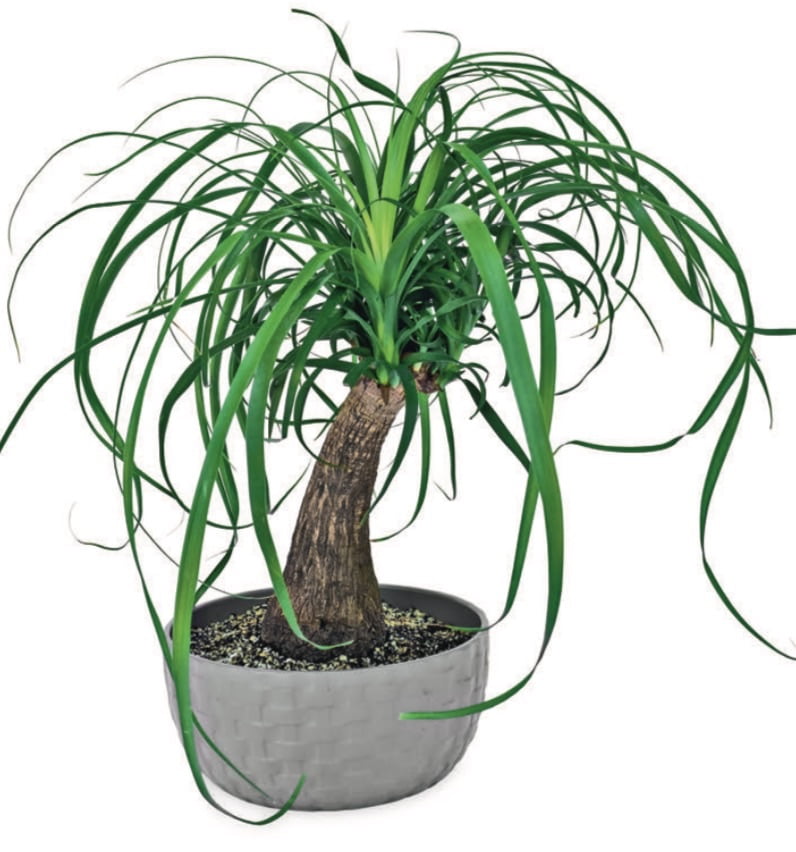[Ebook Việt Hoá] Houseplant Party: Fun projects & growing tips for epic indoor plants - Lisa Eldred Steinkopf, Chi Beaucarnea
[Ebook Việt Hoá] Houseplant Party (Lisa Eldred Steinkopf) – PONYTAIL PALM, ELEPHANT FOOT, BOTTLE PONYTAIL: Beaucarnea recurvata
- Nguồn: Ebook Houseplant Party: Fun projects & growing tips for epic indoor plants – Lisa Eldred Steinkopf
- Biên tập: Dũng Cá Xinh
- Dịch: Team Codai.net
English

It’s a good thing we have Latin scientific names for plants, because they can have many common names, as is the case with Beaucarnea recurvata. Most often, though, it is known as the ponytail palm—even though it’s not a palm at all. If you’ve ever seen one, it will be obvious why the ponytail name was chosen. The long, strappy leaves start out very tight together where they come out of the stem. They look as if they are tied together with an elastic band.
The swollen bulbous stem (called a caudex) resembles the leg of an elephant, especially as the plant ages. This large stem stores water like a camel’s hump, and because of this fea- ture, this plant doesn’t need to be watered often. In fact, a pony- tail palm should not be watered until the potting medium is almost completely dry. It is a light-loving plant originating in parts of the southwestern United States. If it’s placed in a low-light situation, the usually thick, leathery leaves may become thin and floppy.
In its native habitat, a ponytail palm can reach up to 30 feet (9 m) tall! But inside, it will only reach a few feet (less than 1 m) in height, and this over many years as it’s a slow grower. Use a clay pot when planting ponytail palms; it allows evaporation of water through the walls of the pot, helping prevent the soil from becoming waterlogged.
Tiếng Việt

Thân củ phình to (gọi là thân) giống như chân của một con voi, đặc biệt là khi cây già đi. Thân cây lớn này tích trữ nước giống như bướu của lạc đà, và do đặc tính này nên cây này không cần tưới thường xuyên. Trên thực tế, không nên tưới cây cọ đuôi ngựa cho đến khi ruột bầu gần như khô hoàn toàn. Nó là một loại cây ưa sáng có nguồn gốc ở các vùng phía Tây Nam Hoa Kỳ. Nếu nó được đặt trong điều kiện ánh sáng yếu, những chiếc lá thường dày, bằng da có thể trở nên mỏng và mềm.
Trong môi trường sống bản địa của nó, cọ đuôi ngựa có thể cao tới 30 feet (9 m)! Nhưng bên trong, nó sẽ chỉ đạt chiều cao vài feet (dưới 1 m) và điều này qua nhiều năm vì nó là loài sinh trưởng chậm. Sử dụng chậu đất khi trồng cọ đuôi ngựa; nó cho phép nước bốc hơi qua thành chậu, giúp đất không bị úng.
![[Ebook Việt Hoá] Houseplant Party (Lisa Eldred Steinkopf) – PONYTAIL PALM, ELEPHANT FOOT, BOTTLE PONYTAIL: Beaucarnea recurvata [Ebook Việt Hoá] Houseplant Party (Lisa Eldred Steinkopf) – PONYTAIL PALM, ELEPHANT FOOT, BOTTLE PONYTAIL: Beaucarnea recurvata](https://vn1.vdrive.vn/codai.net/2021/04/ebook-houseplant-party-10-ponytail-palm-elephant-foot-bottle-ponytail-beaucarnea-recurvata.jpg)


